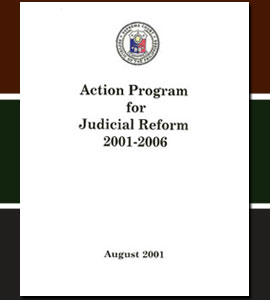Action Program for Judicial Reform

EXECUTIVE SUMMARY
The Judiciary has been constantly aware of the many challenges to its efficient performance, and efforts to address various concerns, though numerous, have been sporadic. But over the last two years, the Judiciary has taken concrete steps to establish a strong foundation for the long-tenn development of the judicial branch. One of the fundamental strides taken ir, the preparation of an Action Program for Judicial Reform with a wide-ranging yet comprehensive set of reform projects and activities aimed at enhancing judicial conditions and performance for the improved delivery of judicial services.
This Action Program for Judicial Reform (APJR) is founded on the vision and mission espoused by Chief Justice Hilario G. Davide, Jr. and enunciated in the Davide Watch.
VISION
“A Judiciary that is independent, effective and efficient, and worthy of public trust and confidence; and a legal profession that provides quality, ethical, accessible and cost-effective legal service to our people and is willing and able to answer the call to public service.”
MISSION
In pursuing the stated vision, the Davide Watch articulates the following goals: (1) delivery of speedy and fair dispensation of justice to all; (2) judicial autonomy and independence from political interference; (3) improved access to judicial and legal services; (4) improved quality of external inputs to the judicial process; (5) efficient, effective and continuously improving judicial institutions; and, (6) a judiciary that conducts its business with dignity, integrity, accountability and transparency.
The APJR builds on previous reform efforts by the Supreme Court, including the Technical Assistance to the Philippine Judiciary On Justice And Development Project, which produced the “Blueprint of Action for the Judiciary,” and the following diagnostic studies: Assessment of Past Judicial Reform Efforts; Formulation Of Administrative Reforms; Review of the Criminal Justice System, Review of the Alternative Dispute Resolution Mechanism, Review of the Barangay Justice System, Assessment of the Impact of Judicial Educ6n on and Directions for Change and Development, and Formulation of a Medium-Term Public Investment Program for the Judiciary. These studies established basic data providing the rationale for the proposed investments for the Judiciary, which had been identified in the “Blueprint.” These also provided the basis for the development of concrete projects and activities to realize the Judiciary’s vision.
